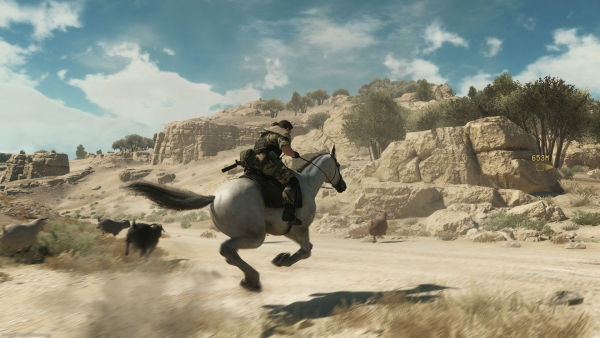Connector Editor
Oh, how the times change and the mighty fall to rest. For more than 28 years, the “Metal Gear” franchise has stood as a benchmark for cinematic storytelling and stealth gameplay excellence. With its unforgettable characters, stunning set-piece moments, and an outrageous sense of humor to match its storytelling prowess, the series has unquestionably left an impact on the gaming industry that is not likely to be forgotten any time soon. Now, with the departure of series creator Hideo Kojima as well as the ongoing collapse of publisher Konami, it seems more than likely that “Metal Gear Solid V: The Phantom Pain” will be the final chapter in the historic series. If this ends up being the case, it is hard to say the franchise has not ended on a high note.

Photo courtesy of Konami Digital Entertainment
Our story begins in a small hospital just outside Afghanistan with series protagonist Big Boss, or Snake if you are feeling old-school, awaking from a coma nine years after his entire life came crashing down around him. In events covered during “Metal Gear Solid V: Ground Zeroes,” last year’s prologue to “The Phantom Pain,” Snake’s private mercenary force was attacked by the shadowy organization known as Cipher, leading to the deaths of everyone involved in the incident and Snake being left for dead
Now, nine years wiser and with revenge on the mind, the Boss is ready to rebuild his private army one more time and fight Cipher. Without giving anything away, the story this time around is noticeably weaker compared to previous installments, with pacing issues galore and far too much important information relegated to optional audio diaries rather than brought to light through character interaction. The game still has its fair share of standout sequences, including an opening which ranks among the best video game openings of all time, but it is nonetheless disappointing to find a series that prides itself so much on storytelling to fall flat here.
It is a good thing that gameplay is more than prepared to pick up the slack. “Metal Gear” has never felt more fun to play thanks to a newly revamped control scheme, smart level design and a retooled set of abilities that give the player more options than ever before. For the first time in the series, every mission takes place within an open world environment that leaves the player to come at their objective in any way they see fit, whether that be sneaking by the enemy unnoticed, killing everything in sight with reckless abandon, or anything in between. This renewed freedom in the level design allows for a whole suite of crazy water-cooler moments that you would normally expect from the latest “Far Cry” games, but enhanced with the signature over the top insanity of “Metal Gear” and an excellent attention to detail.
Enhancing this “do it however you want to” mentality is the brand new base management mechanics. During missions, the player is given a limited supply of Fulton Extraction balloons, which they can use to kidnap soldiers off of the battlefield and recruit them into your personal private army, The Diamond Dogs. Once they have been convinced to join your army (through methods which are, hilariously, never actually explained), you can then assign them to various departments depending on their personal skills, with each of these departments assisting you on missions, from developing new weapons and equipment to providing on-site assistance via supply drops and bombing runs. Not only does this mechanic consistently keep gameplay fresh with new options given to the player every step of the way, it also preserves the series’ reputation as a stealth franchise by incentivizing the player to kill as few enemies as possible, since each soldier you kill is one less you can forcibly recruit. It also helps that attaching a balloon to an unconscious guard’s back and watching as they shoot into the sky screaming bloody murder never stops being hilarious.
What is doubly impressive about “The Phantom Pain” is the extensive amount of quality content available, which far eclipses the offerings of previous games in the series. As of this review, I have put about 30 to 35 hours into the game, which includes completing the main story, engaging in multiple side quests, and building the Diamond Dogs into a staff of 400 soldiers, and even now my total completion percentage (which is displayed for all to see on the game’s main menu) has yet to crack 40% of the content on offer. Further increasing the activities on offer are the ability to replay completed missions with optional objectives, a massive epilogue that concludes the stories of the game’s main cast, an optional multiplayer mode involving the invasion of other player’s military bases to steal their resources, and a full-fledged competitive multiplayer mode set to be released to all owners of the game this October. While, unfortunately, the online portion of the game has, as of this review, been fairly unstable and has caused multiple glitches and longer loading times, the game can be played in an offline mode which alleviates these issues.
It speaks to just how excellent “Metal Gear Solid V: The Phantom Pain” is that, even though it fails to deliver the compelling story that most people would expect from the final game in a franchise that built itself on its narrative, it is still without a doubt one of the best games to be released this year. This game is an obvious labor of love from start to finish, with a slavish attention to detail, an uncompromising amount of content to experience, and gameplay that serves as the benchmark for all stealth games to come. While it probably won’t be the fan favorite of the series, it is unquestionably the best. You are pretty good, Kojima. You are pretty good.




